We noticed you are blocking ads. DO THE TON only works with community supporters. Most are active members of the site with small businesses. Please consider disabling your ad blocking tool and checking out the businesses that help keep our site up and free.
You are using an out of date browser. It may not display this or other websites correctly.
You should upgrade or use an alternative browser.
You should upgrade or use an alternative browser.
~1935 Hardinge Cataract Bench Lathe Restoration
- Thread starter SONICJK
- Start date
crazypj
Split personality, I fake being smart
I wouldn't spin it too fast unless your grinding the shaft?
You'll probably find 2,500rpm is too much for plain bearings with grease or drip feed lubrication.
It may be better to fabricate a reduction gear train then fit a pulley for final drive and speed reduction to around 1200rpm
Lower speed with higher torque means you can take deeper roughing cuts, 0.100" or more on alloy even on a small lathe
You'll probably find 2,500rpm is too much for plain bearings with grease or drip feed lubrication.
It may be better to fabricate a reduction gear train then fit a pulley for final drive and speed reduction to around 1200rpm
Lower speed with higher torque means you can take deeper roughing cuts, 0.100" or more on alloy even on a small lathe
SONICJK
Reminds me of...me No, I'm sure of it. I hate him
crazypj said:I wouldn't spin it too fast unless your grinding the shaft?
You'll probably find 2,500rpm is too much for plain bearings with grease or drip feed lubrication.
It may be better to fabricate a reduction gear train then fit a pulley for final drive and speed reduction to around 1200rpm
Lower speed with higher torque means you can take deeper roughing cuts, 0.100" or more on alloy even on a small lathe
PJ at some point in this lathe's past it was modified internally to hold 3 very high end roller bearings that are still in new condition, so there shouldn't be an issue there.
The plan at the moment is to turn the flywheel shaft on the motor into the pulley essentially, I will turn it down to a V groove and that will give me about a 1" pulley (which I think is still big enough to run a good flexible V bent (anyone know for sure?)
The pulley on the shaft of the lathe is 2.25" so that gives me a 1:2.25 reduction in speed so I'll get a 3100RPM top speed(way too high IMO, but I like the simplicity of not having to run multiple pulleys and belts).
My thought here is also that the motor spins at 7000 but thats a no load top speed, with the load of the lathe I would guess it would slow down considerably from the friction in the bearings and the weight of the rotating assembly. Maximum power from a DC motor should be at around half of its top speed
The motor is being upgraded from .5 HP AC to 2.5HP DC so I doubt power will be a problem even if I am never running it over 2000 rpms?
Thoughts?
I know you are way more experienced here than I, so all help is appreciated.
SONICJK
Reminds me of...me No, I'm sure of it. I hate him
bowman41 said:How did I miss this. Great woodworking skills by the way.
Thanks man, it's what I do for a living, so I hope so ;D
crazypj
Split personality, I fake being smart
With roller/taper bearing conversion it should be good to 5k for short periods. I would use chain lube sprayed into bearings, it's high pressure lube thatwill provide a great boundary layer
I mostly use slow speeds, not in any particular rush (speeds and feeds are for production work, maximise output without too frequent tool changes)
High speed steel tooling is more than adequate at lower speeds, plus it will take a sharper edge than carbide tooling (and it's MUCH cheaper)
I have various replacement tip and brazed tip carbide tools but I can't remember the last time I used them
You may find 1" dia is too small for a decent sized V-belt, provably better to bore out a 2"~3" pulley.
Do you have a reverse tumbler? If not it's probably worthwhile making an intertmediate shaft which would also reduce speed to something more manageable with standard pulleys or even an old transmission
I mostly use slow speeds, not in any particular rush (speeds and feeds are for production work, maximise output without too frequent tool changes)
High speed steel tooling is more than adequate at lower speeds, plus it will take a sharper edge than carbide tooling (and it's MUCH cheaper)
I have various replacement tip and brazed tip carbide tools but I can't remember the last time I used them
You may find 1" dia is too small for a decent sized V-belt, provably better to bore out a 2"~3" pulley.
Do you have a reverse tumbler? If not it's probably worthwhile making an intertmediate shaft which would also reduce speed to something more manageable with standard pulleys or even an old transmission
SONICJK
Reminds me of...me No, I'm sure of it. I hate him
crazypj said:Sometimes you want lead screw to reverse with motor turning normal direction (cutting left hand threads, boring to bottom of blind holes, etc)
Gotcha, there's no lead screw on this old beast so no worries there haha.
After ungodly amounts of work the lathe is stripped and almost ready for a bunch of coats of super high build primer.
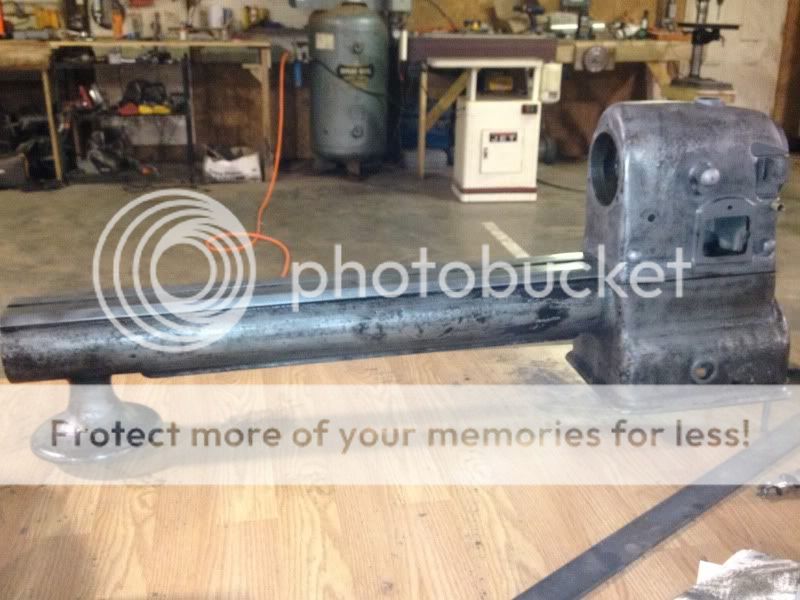
Also got the compound all cleaned up. Purple power soak for 24 hours and then a whole bunch of 0000 steel wool and some disassembly and it's good as new.
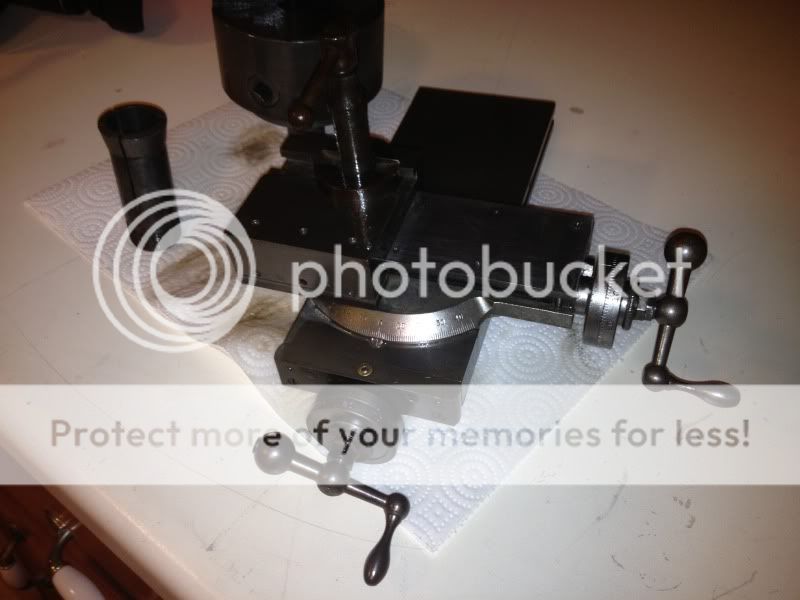
crazypj
Split personality, I fake being smart
Guess you'll have to assemble everything and see how well it works.
Cast iron is great to damp out vibration so you can probably make some real accurate stuff as long as bed doesn't dip near headstock?
Have you got various micrometers yet for the precision stuff? (valve guides, bearing bushes, just because you can, etc ;D )
0-1" and 0.25mm with vernier scale (unless you have a bunch of cash to get electronic read out)
Harbor Freight caluper is OK but only measures to half a thou (0.0005") vernier micrometer will easily measure to one ten-thousandth of inch (0.0001") or 1/1000 of mm (0.001mm)
Cast iron is great to damp out vibration so you can probably make some real accurate stuff as long as bed doesn't dip near headstock?
Have you got various micrometers yet for the precision stuff? (valve guides, bearing bushes, just because you can, etc ;D )
0-1" and 0.25mm with vernier scale (unless you have a bunch of cash to get electronic read out)
Harbor Freight caluper is OK but only measures to half a thou (0.0005") vernier micrometer will easily measure to one ten-thousandth of inch (0.0001") or 1/1000 of mm (0.001mm)
SONICJK
Reminds me of...me No, I'm sure of it. I hate him
So heres what I came up with to turn the V pulley into the flywheel shaft:
Slightly precarious? Absolutely.
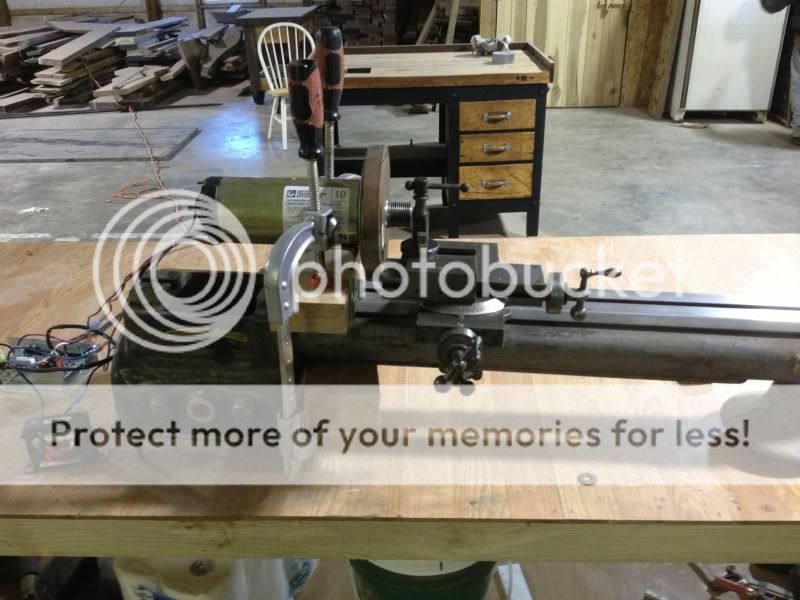
and it worked like a charm:
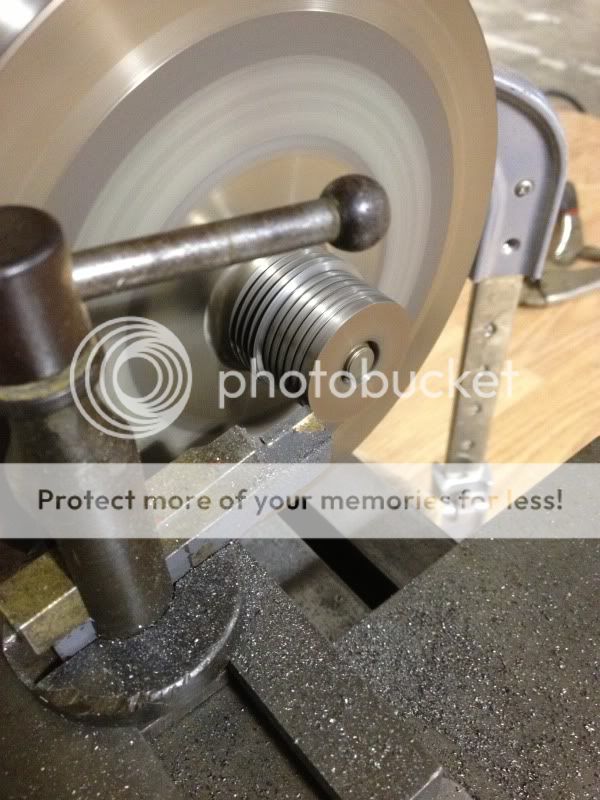
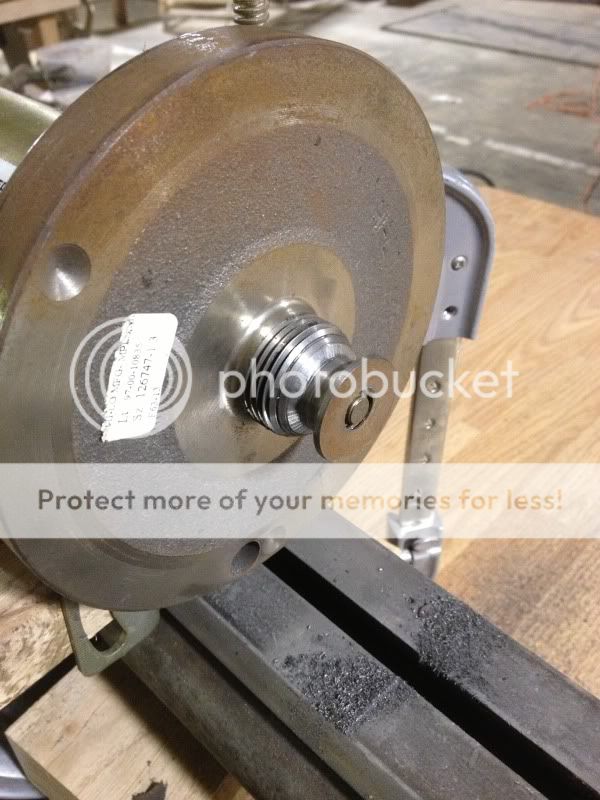
Hooked it to an old belt and with some tension it turns it just fine with minimal slipping in the testing I could do. With a newer more flexible belt it should work just fine I do believe. Pulley diameter is 1" so 1:2.25 gives me theoretical max speed of 3100 RPMS which is more than I'll probably ever use.
Slightly precarious? Absolutely.

and it worked like a charm:


Hooked it to an old belt and with some tension it turns it just fine with minimal slipping in the testing I could do. With a newer more flexible belt it should work just fine I do believe. Pulley diameter is 1" so 1:2.25 gives me theoretical max speed of 3100 RPMS which is more than I'll probably ever use.
SONICJK
Reminds me of...me No, I'm sure of it. I hate him
xb33bsa said:awesome ! ;D
by the way that cemented carbide is 90 off but hey if it works wtf new one on me ;D
Yup good eye, I only have what came with the lathe, so only that right handed carbide, so to get into the left side of the 26 degree belt groove I had to improvise a bit.
And it does work sideways
Wow Sonic, just found this. Very nice work!. I have a 1946 Logan that needs some attention like this.
SONICJK
Reminds me of...me No, I'm sure of it. I hate him
canyoncarver said:Wow Sonic, just found this. Very nice work!. I have a 1946 Logan that needs some attention like this.
Thanks, Get on it!
ALthough I gotta say I did not anticipate this much work going into this :
You will want to pick up one of these eventually: http://www.amazon.com/Machinerys-Handbook-29th-Erik-Oberg/dp/083112900X
crazypj
Split personality, I fake being smart
SONIC. said:Well FUCK.
After all that when I was dismounting the motor from the lathe the controller board shorted itself out in a fantastic puff of smoke.
God.
Damn.
Everything.
Forgot to disconnect from mains?
You can probably get one off eBay reasonable price, cheaper than buying new from manufacturer
JustinLonghorn
No Purple Hearts, No Blue Ribbons
http://frederick.craigslist.org/tls/4286773081.html




